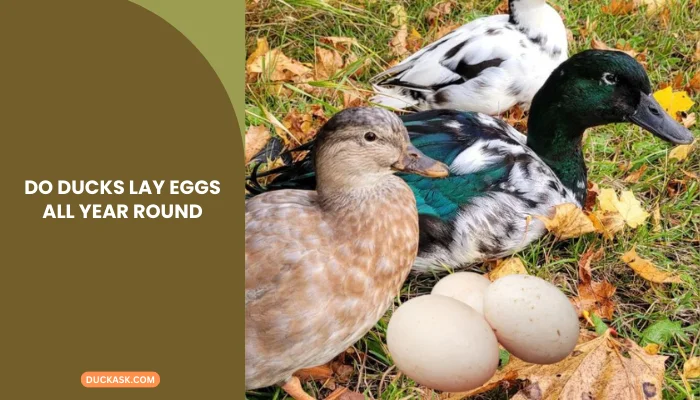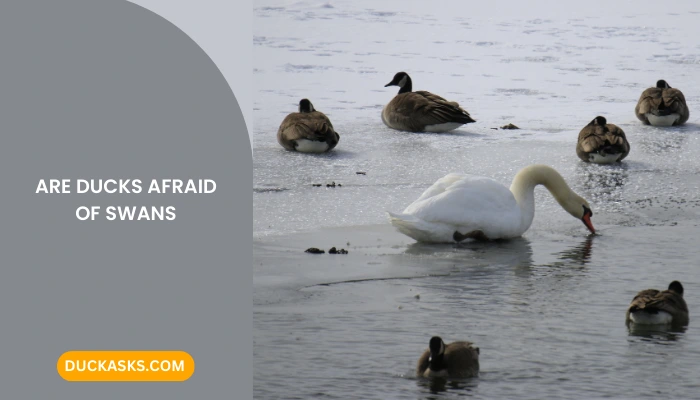Are Wood Ducks Solitary?
When I got to know wood ducks are not entirely monogamous, the first thing that came across my mind was− do they live alone during the non-breeding season? This one question prompted me to dig into this topic, and there I found something really enthralling. So, are wood ducks solitary like I assumed they were?
Nope! They are never in solitude, in fact, they are known for their gregarious nature as they often form large flocks during migration and winter.
Besides, they can establish mixed-species flocks with other types of waterfowl, such as mallards and teals. In their breeding grounds, wood ducks form monogamous pairs throughout the propagation season.
Now that you know that wood ducks are never solitary, be it the breeding season or the non-breeding season, it’s time to discover some unknown facts associated with their harmonious living culture.
Read more about duck habits:
Why Wood Ducks Are Never Alone?
Wood ducks are social birds that typically live-in groups rather than alone. There are several reasons why they prefer to live in groups.
Let’s have a glance over them!

Protection
First, wood ducks are migratory birds that travel in flocks during the winter months. They can protect themselves from predators and harsh weather conditions by staying together in large groups.
This is also true when they are nesting and raising their young, as they are able to provide protection for one another by staying in close proximity.
Social Relationship
Well in case you didn’t know, wood ducks are known to form close bonds with other members of their flock. These birds are often seen preening to one another, which is a sign of social bonding.

They also tend to engage in playful behavior with one another, which is an indication of a strong social bond.
Defending the Territory
Another reason why wood ducks don’t live alone is that they have a strong territorial instinct.
They tend to defend their territory from other wood ducks, which means that they need to live in groups in order to establish and maintain their territory.
This territorial behavior is also seen during the breeding season when males will defend their territory and females from other males.
Communicative Nature
Worth mentioning, wood ducks are known to be highly vocal birds that communicate with one another through a variety of calls.
Living in groups allows them to communicate more effectively and stay informed about the whereabouts of other members of their flock.
In conclusion, wood ducks are social birds that prefer to live in groups for various reasons.
They migrate, raise young and protect themselves from predators and harsh weather conditions, form close bonds, and establish and maintain territory with other wood ducks. It’s just easier to survive in a group setting.
How Wood Ducks Live During the Breeding Season Vs. Non-Breeding Season
Let’s unravel the key contrasts of a wood duck’s lifestyle during the breeding and non-breeding season below.
Breeding Season
During the breeding season, wood ducks engage in a variety of behaviors to attract a mate and establish a territory.
Males will engage in elaborate courtship displays, puffing out their chests and shaking their head plumage to attract females. Once a pair has formed, they will work together to defend their territory from other ducks.

In terms of habitat, wood ducks, during the breeding season, tend to reside near freshwater marshes, swamps, and wooded ponds. This is where they will nest and raise their young.
The females will build a nest in a tree cavity, often near water, and lay between 7 and 15 eggs while the male wood ducks will stay nearby to defend the nest.
Not just it, the females will incubate the eggs for around 30 days and once the eggs have hatched, the females will lead the ducklings to the water and teach them how to forage for food.
The family will then stay together for several weeks until the ducklings can fly and fend for themselves.
Non-Breeding Season
When the non-breeding season transpires, wood ducks will migrate to areas with a more suitable climate and food resources. They tend to congregate in large flocks in places like coastal marshes, estuaries, and freshwater wetlands.
Here, they will feed on a variety of food sources, such as acorns, seeds, and aquatic invertebrates.

Considering their behavior, wood ducks during the non-breeding season are less territorial and more focused on survival and food acquisition.
They will form loose flocks and may even form pair bonds for the winter, but these bonds are not as strong as those formed during the breeding season.
It’s safe to say, that the breeding season is a critical time for wood ducks as they engage in behaviors to attract a mate, establish a territory, and raise their young.
In contrast, the non-breeding season is focused on survival and the acquisition of food. So, the breeding season and the non-breeding season are two different aspects of the life of wood ducks.
Are Wood Ducks Territorial?
If it comes to their territorial behavior, wood ducks are considered to be relatively non-territorial. Let’s wade through the reasons why they are not as defensive towards their territory as other avian beings.
Lack of Protectiveness to One Distinct Territory
Unlike many other bird species, wood ducks do not establish and defend specific territories. Instead, they are known to be relatively social animals that live in small groups or flocks. These groups are often composed of females and their young, as well as a few males.

Wood ducks do not feel an iota of affinity towards their living space; thus, the sense of protection doesn’t evoke. The males do not typically defend specific territories but rather move around within the group and compete for access to females during the breeding season.
Comfortable in Different Habitats
Beside their non-territorial behavior, wood ducks are also known to be relatively flexible in terms of their habitat preferences.
They are found in a wide range of environments, including freshwater wetlands, marshes, and even urban areas. These birds can adapt to changes in their environment, such as the introduction of new predators or changes in water levels.
Long story short, wood ducks are deemed non-territorial who can adapt to a wide range of environments and social situations.
These graceful avian have quite a reputation for their social behavior and their ability to live in small groups. And, they do not typically defend specific territories.
This adaptability allows them to thrive in a wide range of habitats and makes them valuable species to many different ecosystems.
Do Wood Ducks Nest Together?
Wood ducks, are somewhat popular for their nesting habits, which are a bit different from those of other duck species.

These short-winged birds do not typically nest together in large colonies, as many other duck species do. Instead, they tend to nest individually or in small groups.
There Are Two Reasons for This
Reason #1: Wood ducks prefer to nest in tree cavities rather than on the ground or in the water, like many other duck species.
These tree cavities can be found in a variety of locations, including in old-growth forests, along rivers and streams, and even in urban areas with mature trees.
Because of this preference for tree cavities, wood ducks often must search for and compete for suitable nesting sites. This competition can lead to wood ducks nesting individually or in small groups rather than in large colonies.
Reason #2: Another reason for these ducks not nesting together is their mating habits. Wood ducks are known for their strong pair bonds, and each pair will typically only mate with one partner during the breeding season.
This means that fewer ducks are competing for nesting sites, which can lead to more individual nesting. Overall, while wood ducks do not typically nest together in large colonies like many other duck species, they are still an important part of many wetland ecosystems.
They play a vital role in seed dispersal, and their unique nesting habits help to maintain the diversity of tree cavities in their habitats.
Brood Parasitism – Wood Duck Nesting Habit
The term brood parasitism refers to a reproductive strategy where a female bird lays her eggs in the nest of another bird, known as the host. The host then incubates and raises the young as if they were their own.
One species that has been observed engaging in brood parasitism is the wood duck.
They are known to lay their eggs in the nests of other wood ducks, as well as those of mallards and other duck species. This behavior is thought to be an adaptation to the wood duck’s highly territorial and competitive breeding habits.

By laying her eggs in the nest of another bird, the parasitic female can avoid the costs of building a nest and defending a territory.
However, brood parasitism can also have negative effects on the host birds. The host may be forced to raise younger than they can handle, leading to a decrease in the survival rate of the host’s own offspring.
On top of that, the host may become exhausted from the increased workload and be less able to defend their territory and find food.
Is Brood Parasitism Normal Among Them?
Despite these negative effects, brood parasitism is a common behavior among wood ducks. Studies have shown that approximately 10-15% of wood duck nests are parasitized.
This suggests that the benefits of brood parasitism, such as avoiding the costs of nest-building and territory defense, outweigh the negative effects on the host.
Seems like the wood ducks have taken the expression “Don’t Put All Your Eggs In One Basket” too literally.
Are Wood Ducks Monogamous?
Wood ducks, also known as Aix sponsa, are monogamous but seasonally.
It means that they form a bond with one mate for the duration of the breeding season (this bond is typically formed between March and June and lasts until the eggs have hatched and the ducklings have fledged).

And for the next copulation season they hop on to finding a new mate once the non-breeding season ceases to exist.
You can divide their pre-mating and post-mating activity into two parts, such as the breeding season and after the eggs have hatched. Let’s have a look!
Pre-Mating
During the breeding season, the male wood duck will perform elaborate courtship displays to attract a mate. This can include preening, calling, and displaying his bright plumage. Once a female is attracted, the pair will bond and defend their territory together. They will also work together to build a nest and incubate the eggs.
Post-Mating
After the eggs have hatched, the male will leave the female to care for the ducklings on her own. This is known as ‘Nest Desertion’. And it’s common among many duck species. The male will then begin the process of finding a new mate for the next breeding season.
It is worth noting that while wood ducks are monogamous during the breeding season, they may not necessarily remain with the same mate year after year.
Studies have shown that wood ducks can change mates from one year to the next. This is known as Extra-Pair Copulation, and it is believed to be a strategy to increase genetic diversity in the population.
However, during the breeding season, the pair will work together to build a nest and incubate the eggs, and the male will leave the female to care for the ducklings on her own.
End Quote
Getting back to the original topic of concern which was− Are wood ducks solitary? Now you and I both can deduce that they never dwell in a vacuum, be it an emotional, physical, or geographical state. Regardless of the ever-changing seasons, you will seldom spot a wood duck living alone.
That being resolved, if you have further interest regarding ducks, then feel free to connect with us through Facebook, Twitter, and Pinterest.
Image Credit: Canva.com/photos






